| Tips for using parish records |
| - It is worth remembering that before 1752 the year started on 25 March and ran through to 24 March, so January, February and most of March in any given year came after April to December in that year.
- There can be gaps in the registers. Perhaps the incumbent died and there was a short period before the next was appointed.
- Gaps occurred during the English Civil War and the Interregnum period in the mid-1600s.
- While babies were usually baptised shortly after birth, sometimes several siblings were baptised together later on so you might need to extend your search.
- A mother might return to her own mother for the birth of a first baby.
- Not all parishes were in existence at the start of parish records. A small village might have been within a larger parish of a different name and many new parishes were formed as towns and cities grew.
- Errors sometimes creep in when a transcript is made and not all the information contained in the original records is necessarily included in a transcribed or printed copy. Witnesses to a marriage might not be included even though they can be a vital link. You should always make a point of checking with the original. |
'Our Annie', as my grandmother called her sister, was born in 1867, the second child of William Benson and his wife Sarah Ann nee Ruston. Known to my mothers and my generation as Auntie Annie, when my mother and her sisters helped me draw up my first family tree long after my grandmother and Auntie Annie had died, she appeared as Annie Elizabeth in my grandmother's birthday book. Her death, presumably registered by one of her children, records her in the indexes as Annie E.
The records on this site are pre-1837, the most useful to have available as they pre-date the general registration of births, marriages and deaths begun in 1837
My grandmother was one of the nine so it's unlikely that I would have wanted to invest in birth certificates for all her siblings but had I wanted to it is unlikely that I would have easily found Annie's. Parish records were a different matter and when I looked up the baptisms of William and Sarah Ann's children I discovered that this daughter was actually christened Hannah Elizabeth. Somehow it gave me a different view of the old lady I remembered visiting as a child.
In the beginning
It was Thomas Cromwell, Vicar-General to King Henry VIII back in 1538, who first ordered the keeping of records for baptisms, marriages and burials in each parish. While some very early records survive, not all parishes complied and in 1598 the original order was reinforced. Also from 1598 each parish incumbent had to make a full copy of each year's entries and forward this to the bishop of the diocese. These copies are known as Bishops' Transcripts and when parish registers have been lost they can sometimes fill the gap.
In the early years the amount of information provided depended on the person writing up the records, so the detail varied considerably from one parish to another. From 25 March 1754 Hardwicke's Marriage Act meant that standard forms were completed for marriages and Rose's Act of 1812 meant that from 1813 baptisms and burials were also entered on standard forms.
Finding Parish Records
Parish Registers are now largely in the relevant local record office/archives and over the years some registers have been transcribed and printed. But there is no convenient central index in which you can search these parish registers so any parish records online are very welcome indeed.
TheGenealogist at www.thegenealogist.co.uk has a good range of both transcribed and scanned printed copies available to search online. At the moment these include entries from 34 out of the 40 English counties but more will be added. Be aware that only a few parishes might be included for any one county and the time range can be limited. Other counties might well be represented. Check coverage at: www.thegenealogist.co.uk by clicking on the two relevant Parish Records links.
The records on this site are pre-1837, the most useful to have available as they pre-date the general registration of births, marriages and deaths begun in 1837 and the census returns which survive from 1841.
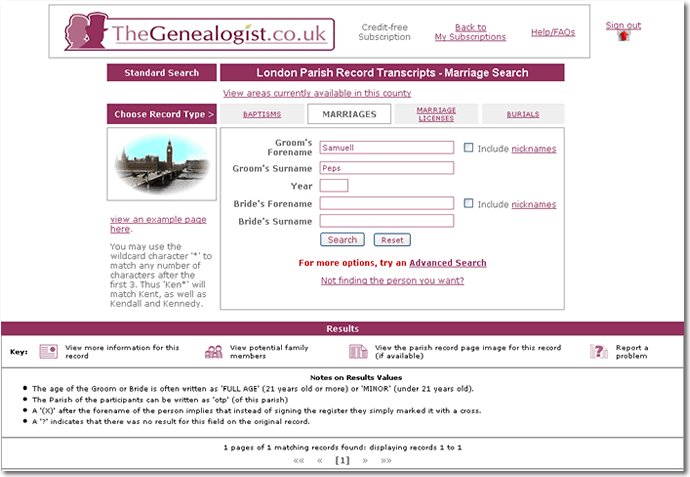 |
| Above: A search for 'Sam* Pep*' under London Parish Records (Transcripts) on TheGenealogist.co.uk turns up a record of the famous diarist's marriage to Elizabeth Marchant in St Margaret's Church, Westminster in 1655. Using a wildcard (*) helps as Samuel Pepys has been recorded as 'Samuell Peps'. |
| |
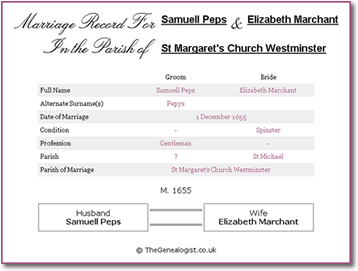 |
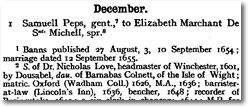
Left: You can print out an attractive, clear record of your ancestor's vital event, such as this marriage record for Samuel and Elizabeth Pepys.
Above: Original image of the record.
|
The two sections - the transcribed records and the printed books - are accessed in slightly different ways.
How to Search
| Research Log site tool |
When you are searching the records you will often end up with several possible results, especially with census entries, and it can be frustratingly difficult to keep tabs on these, so make use of the Research Log tool. When you have run your search and have scrolled down to your census results, you'll see that the extreme left-hand column is headed 'Research Log' with a small box against each result. If several of these results could be relevant to your research, tick the box alongside each one and then click on 'Save Record(s) to Research Log.' Once you have clicked on 'Save' you will see a message telling you that the records have been saved. Go to your Research Log by clicking on the tab at the top of the Research View page to see your saved records. What makes this tool so useful is that when you view your saved records, you can add comments to each one if you wish. Comments such as 'Right birthplace but age three years out' or 'Right age and parents but birthplace not recognised' are just what is needed when you return to these records some time later! At the moment you can also add birth, marriage and death records from 1984 onwards but soon you will be able to add parish record transcripts too. |
If you don't have a subscription to TheGenealogist just go to www.thegenealogist.co.uk/freesub for a free trial - once you have registered you will be given 25 credits to try out the service. Then log on to the Research View page and scroll down first to 'Parish Records (Transcripts)'. Clicking on the drop-down box will reveal a total of 25 counties, most of which have records of baptisms, marriages and burials. Some of these counties, however, have only marriages or baptisms available. Choose your county by clicking on the name to highlight it then click on 'Search'. This will bring up a search box in which you can opt for baptisms, marriages or burials. For baptisms and burials you can enter a forename, checking the box to include nicknames such as Betty or Liz, and a surname. You can also include a year. For marriages you can use both groom's and bride's names. You can use a wildcard (*) after three letters so that, for example, Ben* will find Benson and Bentley.
To include more information you can opt for the 'Advanced Search'. For baptisms, this allows you to add a range of +/- up to 30 years around the chosen year and to include the abode and the forenames of both father and mother, together with the father's occupation. You can also select one or all of the parishes. You can include the age, father's name and parish of both the groom and bride, and even the names of witnesses, if known. For burials, 'Advanced Search' allows you to specify an extended year range, the age and abode of the deceased and also select the parish.
Remember, though, that not all entries will include all these details and that the information you have might not always match the information given in the entry - ages in particular can be unreliable. All this means that if you input too much information you might not find what you are looking for, so be flexible! However, you must enter at least a surname.
If you input too much information you might not find what you are looking for, so be flexible! |
Once you have entered your information, click on 'Search' then scroll down to view the results. Assuming the details are included in the entry you will have, for baptisms, the surname, first name(s), date, area and any other recorded remarks. For marriages the results included the forename(s), surname and age for both groom and bride, the date and the place. For burials you will have surname, forename(s), age, abode, date and area (parish). You can rearrange these results by any column by clicking on the relevant column heading.
For all entries there is the option to view the full record by clicking on the icon at the side of each one. This brings up an attractively presented record which you can then print.
To search the other section of parish records - the printed books - scroll down to 'Parish Records (Printed Books)' on the Research View page. Click on the drop-down box to bring up the 28 counties available, choose your county, highlight it, then click 'Search'. Most of these counties are limited to marriage records but five (London, Cambridgeshire, Northumberland, Surrey and Yorkshire) also include baptisms and burials. Again not all parishes are currently included.
Once you have clicked on 'Search' you will find a search form with a different layout. This time you have a box in which you list your search terms in order of priority, perhaps surname first, then forename. Select all or one of the parishes by highlighting or typing into the 'quick select' box. Click 'Search' then scroll down the page to see the results. If selecting 'all parishes' returns too many hits you will be asked to limit your search.
Several parishes will probably be grouped together in one volume but you can view the relevant page by clicking the 'click to view page' icon on the right. You can then ask the image viewer to highlight your search terms within the page by clicking on the binocular icon in the toolbar on the left, but, in fact, it's easy enough to just scroll through the entries. You can save and/or print the page or download it as a PDF file.
Always be prepared for spelling variations, especially in the earlier years. My Hazlewood family was recognisable as 'Hasselwood' and even 'Hazloud' but I almost missed an early 'Azlud' entry!
| Step-by-step search |
|
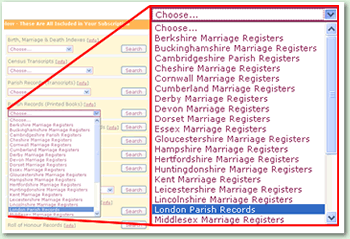 |
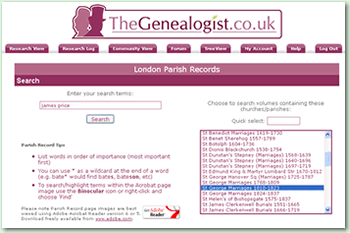 |
| 1) Access the parish records (Transcripts or Printed Books) on the Research View page. Use the drop-down list to choose the relevant records - in this case, we chose London Parish Records in the Printed Books section. |
2) Clicking on 'London Parish Records' takes you to the relevant search page. We searched for James Price in the St George Marriages 1810-1823. |
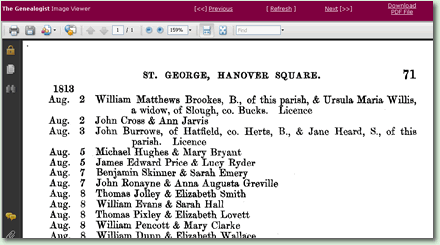
|
| 3) This led us to the marriage record for James Edward Price and Lucy Ryder on 5 August 1813. |
|